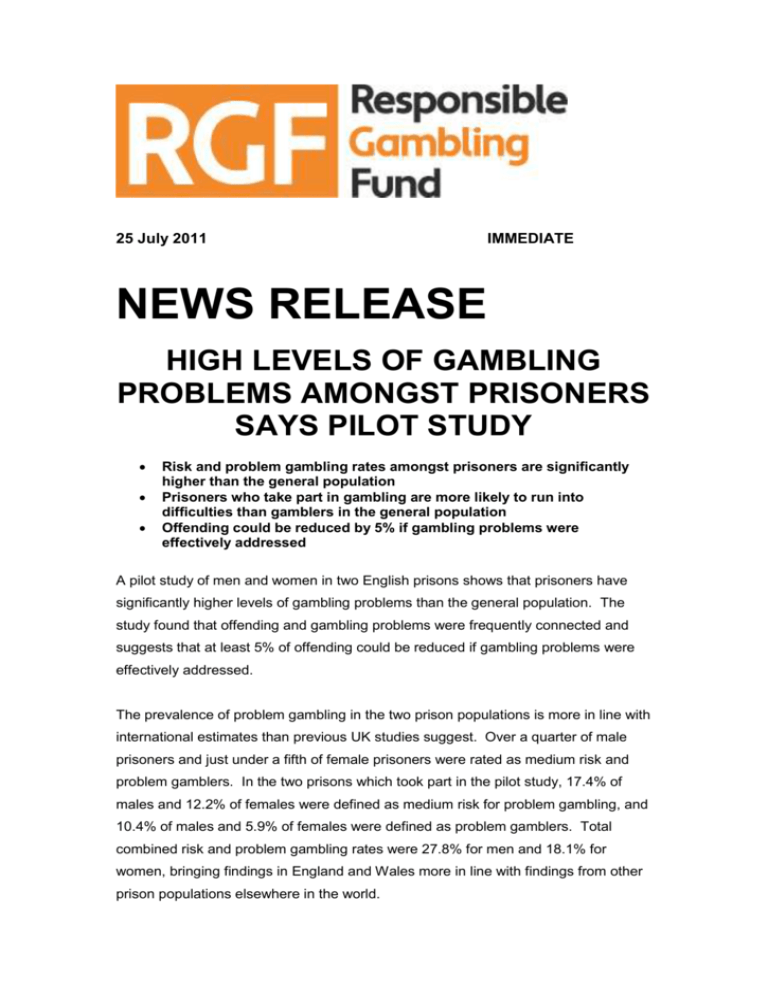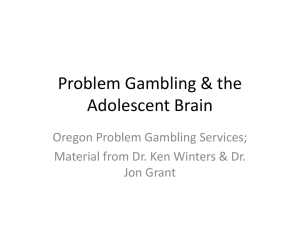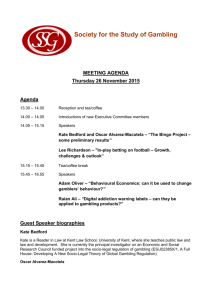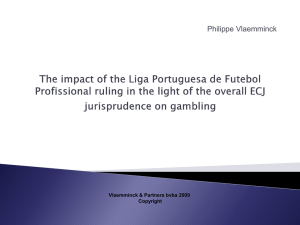High levels of gambling problems amongst prisoners says pilot study
advertisement

25 July 2011 IMMEDIATE NEWS RELEASE HIGH LEVELS OF GAMBLING PROBLEMS AMONGST PRISONERS SAYS PILOT STUDY Risk and problem gambling rates amongst prisoners are significantly higher than the general population Prisoners who take part in gambling are more likely to run into difficulties than gamblers in the general population Offending could be reduced by 5% if gambling problems were effectively addressed A pilot study of men and women in two English prisons shows that prisoners have significantly higher levels of gambling problems than the general population. The study found that offending and gambling problems were frequently connected and suggests that at least 5% of offending could be reduced if gambling problems were effectively addressed. The prevalence of problem gambling in the two prison populations is more in line with international estimates than previous UK studies suggest. Over a quarter of male prisoners and just under a fifth of female prisoners were rated as medium risk and problem gamblers. In the two prisons which took part in the pilot study, 17.4% of males and 12.2% of females were defined as medium risk for problem gambling, and 10.4% of males and 5.9% of females were defined as problem gamblers. Total combined risk and problem gambling rates were 27.8% for men and 18.1% for women, bringing findings in England and Wales more in line with findings from other prison populations elsewhere in the world. The three-year pilot study by a research team at the University of Lancaster was funded by the Responsible Gambling Fund (RGF), the national charity that distributes funds for gambling research, education and treatment. A second study, funded by RGF and the Economic and Social Research Council, examining the questions raised by the pilot in more depth, is now under way. Almost 60 per cent of male and nearly 40 per cent of female prisoners had taken part in some form of gambling before going to prison. Researchers also found that attitudes to gambling were broadly comparable with the national averages in the British Gambling Prevalence Survey. However, prisoners tended to be more in favour of people having the right to gamble whenever they want and to be against banning gambling altogether. There was a significant difference between total attitudinal scores for women in prison and those in the community, with those in prison having more favourable attitudes towards gambling overall. There were no significant differences between the two male populations. Prisoners told researchers of some of the links prisoners made between offending and their current crime. These included arguing with a partner and selling drugs to get money to gamble; stealing from family members to gamble; and getting into fights over gambling. One prisoner believed there is a link between her being a ‘street working young woman’ and gambling. Another regarded gambling in prison as a guilty pleasure, while recognising that it sometimes leads to potentially violent confrontations between prisoners. Corinne May-Chahal, Professor of Applied Social Science at the University of Lancaster, says: “It’s important for prisons to screen for problem gambling because it doesn’t present itself as obviously as alcohol and drugs problems. It’s equally vital that, once prisoners with gambling problems are found, the prison authorities take steps to tackle the problem because action taken in prison may play a part in reducing levels of re-offending.” Jim Fearnley, Head of Policy and Research at RGF comments: “If this pilot’s findings are representative of the prison population at the time the research took place they reveal a worrying level of problem gambling amongst offenders in England and point to the need for co-ordinated national activity to tackle gambling problems in the criminal justice system.” Chris Bath, of UNLOCK, the National Association of Reformed Offenders adds: “Although prisons have increasingly recognised the importance of personal financial responsibility in reducing re-offending, gambling has simply not been on the radar. This report shows people with gambling problems need support, whether they are in prison or the community.” ENDS (595 words) RGF press contact: Alan Ali on 07403 147 311 and alan.ali@rgf.rgsb.org.uk UNLOCK press contact: Chris Bath on 07917 864007 or 01634 247350 and chris.bath@unlock.org.uk University of Lancaster press contact: Gillian Whitworth on 01524 592612 and gillian.whitworth@lancaster.ac.uk Notes to Editors: RGF is a charity that was set up in June 2009 to provide support for research, educational and treatment services across the gambling field. It is supported by charitable donations from the gambling industry and distributes funds for gambling research, education and treatment. www.rgfund.org.uk The OffGam pilot study involved a prevalence study in 2 prisons (Prison A, a male prison in the North of England and Prison B, a female prison in the South) and the trialling of a prison based intervention programme. The response rate to the questionnaire was high, perhaps indicating prisoner interest in this subject. A total of 201 completed responses were received in Prison A and 222 in Prison B giving a response rate of 64% and 56% respectively and a total sample of 421 prisoners. Problem gambling was measured on the Problem Gambling Severity Index (PGSI) used in the British Gambling Prevalence Study (BGPS) (Wardle et al., 2007). The questionnaire used in the study focused on lifetime prevalence rather than the previous 6 or 12 months. A short version of the full report, entitled ‘OffGam: An Evidence Informed Approach to Addressing Problem Gambling in Prison Populations’, is available at www.rgfund.org.uk . The full report will be published in late 2011. In the wider literature of prison studies scores of 3-7 and 8+ on the Canadian Problem Gambling Severity Index (PGSI) are aggregated as ‘problem’ and ‘pathological problem’ gambling. To enable comparison a similar methodology has been applied here (see Williams, R.J., Royston, J., & Hagen, B.F. (2005). Gambling and problem gambling within forensic populations: A review of the literature. Criminal Justice and Behavior, 32(6), 665-689. The University of Lancaster’s Department of Applied Social Science encompasses Lancaster’s teaching and research activities in criminology, social work, social policy and disability studies. http://www.lancs.ac.uk/fass/apsocsci/









